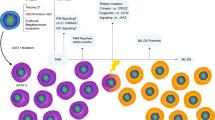Abstract
Children with Down syndrome (DS) and myeloid leukaemia have a significantly higher survival rate than other children, but they also experience considerable treatment-related toxicity. We analysed data on 56 children with DS who were treated on the Nordic Society for Paediatric Haematology and Oncology-acute myeloid leukaemia (NOPHO-AML)88 and NOPHO-AML93 protocols and reviewed the literature. In the dose-intensive NOPHO-AML88 protocol, 8 out of 15 patients (53%) experienced an event. In the less dose-intensive NOPHO-AML93 protocol, 7 out of 41 patients (17%) had an event. Therapy was reduced in 29 patients (52%) with in average 75% and 67% of the scheduled dose of anthracycline and cytarabine, respectively. Treatment-related death occurred in seven who all received full treatment. Relapse and resistant disease occurred at a similar rate in those receiving full and reduced treatment. Review of major series of myeloid leukaemia of DS showed no clear relationship between dose and survival; however, it appears that both a reduction in treatment dose and a less intensively timed treatment regimen improved the outcome. Further studies are needed to define the optimal regimen for treating myeloid leukaemia of DS.



Similar content being viewed by others
References
Gurbuxani S, Vyas P, Crispino JD (2004) Recent insights into the mechanisms of myeloid leukemogenesis in Down syndrome. Blood 103:399–406
Hasle H, Niemeyer CM, Chessells JM, Baumann I, Bennett JM, Kerndrup G, Head DR (2003) A pediatric approach to the WHO classification of myelodysplastic and myeloproliferative diseases. Leukemia 17:277–282
Gamis AS, Woods WG, Alonzo TA, Buxton A, Lange B, Barnard DR, Gold S, Smith FO (2003) Increased age at diagnosis has a significantly negative effect on outcome in children with Down syndrome and acute myeloid leukemia: a report from the children's cancer group study 2891. J Clin Oncol 21:3415–3422
Ravindranath Y (2003) Down syndrome and acute myeloid leukemia: the paradox of increased risk for leukemia and heightened sensitivity to chemotherapy. J Clin Oncol 21:3385–3387
Creutzig U, Reinhardt D, Diekamp S, Dworzak M, Stary J, Zimmermann M (2005) AML patients with Down syndrome have a high cure rate with AML-BFM therapy with reduced dose intensity. Leukemia 19:1355–1360
Lie SO, Abrahamsson J, Clausen N, Forestier E, Hasle H, Hovi L, Jonmundsson G, Mellander L, Gustafsson G (2003) Treatment stratification based on initial in vivo response in acute myeloid leukaemia in children without Down syndrome. Results of NOPHO-AML trials. Br J Haematol 122:217–225
Creutzig U, Ritter J, Zimmermann M, Hermann J, Gadner H, Sawatzki DB, Niemeyer CM, Schwabe D, Selle B, Boos J, Kuhl J, Feldges A (2001) Idarubicin improves blast cell clearance during induction therapy in children with AML: results of study AML-BFM 93. AML-BFM Study Group. Leukemia 15:348–354
Webb DK, Harrison G, Stevens RF, Gibson BG, Hann IM, Wheatley K (2001) Relationships between age at diagnosis, clinical features, and outcome of therapy in children treated in the Medical Research Council AML 10 and 12 trials for acute myeloid leukemia. Blood 98:1714–1720
Taub JW, Huang X, Matherly LH, Stout ML, Buck SA, Massey GV, Becton DL, Chang MN, Weinstein HJ, Ravindranath Y (1999) Expression of chromosome 21-localized genes in acute myeloid leukemia: differences between Down syndrome and non-Down syndrome blast cells and relationship to in vitro sensitivity to cytosine arabinoside and daunorubicin. Blood 94:1393–1400
Frost BM, Gustafsson G, Larsson R, Nygren P, Lönnerholm G (2000) Cellular cytotoxic drug sensitivity in children with acute leukemia and Down's syndrome: an explanation to differences in clinical outcome? Leukemia 14:943–944
Zwaan CM, Kaspers GJ, Pieters R, Hahlen K, Janka-Schaub GE, Van Zantwijk CH, Huismans DR, de Vries E, Rots MG, Peters GJ, Jansen G, Creutzig U, Veerman AJ (2002) Different drug sensitivity profiles of acute myeloid and lymphoblastic leukemia and normal peripheral blood mononuclear cells in children with and without Down syndrome. Blood 99:245–251
Hasle H (2001) Pattern of malignant disorders in individuals with Down’s syndrome. Lancet Oncol 62:429–436
Creutzig U, Ritter J, Vormoor J, Ludwig WD, Niemeyer C, Reinisch I, Stollmann Gibbels B, Zimmermann M, Harbott J (1996) Myelodysplasia and acute myelogenous leukemia in Down's syndrome. A report of 40 children of the AML-BFM Study Group. Leukemia 10:1677–1686
Craze JL, Harrison G, Wheatley K, Hann IM, Chessells JM (1999) Improved survival of acute myeloid leukaemia in Down's syndrome. Arch Dis Child 81:32–37
Lange BJ, Kobrinsky N, Barnard DR, Arthur DC, Buckley JD, Howells WB, Gold S, Sanders J, Neudorf S, Smith FO, Woods WG (1998) Distinctive demography, biology, and outcome of acute myeloid leukemia and myelodysplastic syndrome in children with Down syndrome: Children's Cancer Group studies 2861 and 2891. Blood 91:608–615
Zeller B, Gustafsson G, Forestier E, Abrahamsson J, Clausen N, Heldrup J, Hovi L, Jonmundsson G, Lie SO, Glomstein A, Hasle H (2005) Acute leukaemia in children with Down syndrome: a population-based Nordic study. Br J Haematol 128:797–804
Ravindranath Y, Abella E, Krischer JP, Wiley J, Inoue S, Harris M, Chauvenet A, Alvarado CS, Dubowy R, Ritchey AK, Land V, Steuber CP, Weinstein H (1992) Acute myeloid leukemia (AML) in Down's syndrome is highly responsive to chemotherapy: experience on Pediatric Oncology Group AML Study 8498. Blood 80:2210–2214
Kojima S, Sako M, Kato K, Hosoi G, Sato T, Ohara A, Koike K, Okimoto Y, Nishimura S, Akiyama Y, Yoshikawa T, Ishii E, Okamura J, Yazaki M, Hayashi Y, Eguchi M, Tsukimoto I, Ueda K (2000) An effective chemotherapeutic regimen for acute myeloid leukemia and myelodysplastic syndrome in children with Down's syndrome. Leukemia 14:786–791
The AML Collaborative group (1998) A systematic collaborative overview of randomized trials comparing idarubicin with daunorubicin (or other anthracyclines) as induction therapy for acute myeloid leukaemia. Br J Haematol 103:100–109
Author information
Authors and Affiliations
Corresponding author
Rights and permissions
About this article
Cite this article
Abildgaard, L., Ellebæk, E., Gustafsson, G. et al. Optimal treatment intensity in children with Down syndrome and myeloid leukaemia: data from 56 children treated on NOPHO-AML protocols and a review of the literature. Ann Hematol 85, 275–280 (2006). https://doi.org/10.1007/s00277-005-0045-5
Received:
Accepted:
Published:
Issue Date:
DOI: https://doi.org/10.1007/s00277-005-0045-5




